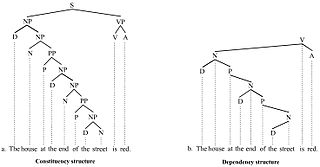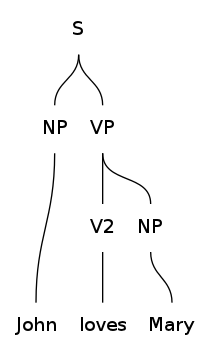
In linguistics, syntax is the study of how words and morphemes combine to form larger units such as phrases and sentences. Central concerns of syntax include word order, grammatical relations, hierarchical sentence structure (constituency), agreement, the nature of crosslinguistic variation, and the relationship between form and meaning (semantics). There are numerous approaches to syntax that differ in their central assumptions and goals.
In grammar, a phrase—called expression in some contexts—is a group of words or singular word acting as a grammatical unit. For instance, the English expression "the very happy squirrel" is a noun phrase which contains the adjective phrase "very happy". Phrases can consist of a single word or a complete sentence. In theoretical linguistics, phrases are often analyzed as units of syntactic structure such as a constituent.
In computer science, the Cocke–Younger–Kasami algorithm is a parsing algorithm for context-free grammars published by Itiroo Sakai in 1961. The algorithm is named after some of its rediscoverers: John Cocke, Daniel Younger, Tadao Kasami, and Jacob T. Schwartz. It employs bottom-up parsing and dynamic programming.

A parse tree or parsing tree or derivation tree or concrete syntax tree is an ordered, rooted tree that represents the syntactic structure of a string according to some context-free grammar. The term parse tree itself is used primarily in computational linguistics; in theoretical syntax, the term syntax tree is more common.
In linguistics, X-bar theory is a model of phrase-structure grammar and a theory of syntactic category formation that was first proposed by Noam Chomsky in 1970 reformulating the ideas of Zellig Harris (1951,) and further developed by Ray Jackendoff, along the lines of the theory of generative grammar put forth in the 1950s by Chomsky. It attempts to capture the structure of phrasal categories with a single uniform structure called the X-bar schema, basing itself on the assumption that any phrase in natural language is an XP that is headed by a given syntactic category X. It played a significant role in resolving issues that phrase structure rules had, representative of which is the proliferation of grammatical rules, which is against the thesis of generative grammar.
Lexical functional grammar (LFG) is a constraint-based grammar framework in theoretical linguistics. It posits two separate levels of syntactic structure, a phrase structure grammar representation of word order and constituency, and a representation of grammatical functions such as subject and object, similar to dependency grammar. The development of the theory was initiated by Joan Bresnan and Ronald Kaplan in the 1970s, in reaction to the theory of transformational grammar which was current in the late 1970s. It mainly focuses on syntax, including its relation with morphology and semantics. There has been little LFG work on phonology.
Parsing, syntax analysis, or syntactic analysis is the process of analyzing a string of symbols, either in natural language, computer languages or data structures, conforming to the rules of a formal grammar. The term parsing comes from Latin pars (orationis), meaning part.
Dependency grammar (DG) is a class of modern grammatical theories that are all based on the dependency relation and that can be traced back primarily to the work of Lucien Tesnière. Dependency is the notion that linguistic units, e.g. words, are connected to each other by directed links. The (finite) verb is taken to be the structural center of clause structure. All other syntactic units (words) are either directly or indirectly connected to the verb in terms of the directed links, which are called dependencies. Dependency grammar differs from phrase structure grammar in that while it can identify phrases it tends to overlook phrasal nodes. A dependency structure is determined by the relation between a word and its dependents. Dependency structures are flatter than phrase structures in part because they lack a finite verb phrase constituent, and they are thus well suited for the analysis of languages with free word order, such as Czech or Warlpiri.
The term phrase structure grammar was originally introduced by Noam Chomsky as the term for grammar studied previously by Emil Post and Axel Thue. Some authors, however, reserve the term for more restricted grammars in the Chomsky hierarchy: context-sensitive grammars or context-free grammars. In a broader sense, phrase structure grammars are also known as constituency grammars. The defining trait of phrase structure grammars is thus their adherence to the constituency relation, as opposed to the dependency relation of dependency grammars.
In linguistics, nominalization or nominalisation is the use of a word that is not a noun as a noun, or as the head of a noun phrase. This change in functional category can occur through morphological transformation, but it does not always. Nominalization can refer, for instance, to the process of producing a noun from another part of speech by adding a derivational affix, but it can also refer to the complex noun that is formed as a result.
In linguistics, antisymmetry is a syntactic theory presented in Richard S. Kayne's 1994 monograph The Antisymmetry of Syntax. It asserts that grammatical hierarchies in natural language follow a universal order, namely specifier-head-complement branching order. The theory is built on the foundation of X-bar theory. Kayne hypothesizes that all phrases whose surface order is not specifier-head-complement have undergone syntactic movements that disrupt this underlying order. Others have posited specifier-complement-head as the basic word order.

In computer science, the syntax of a computer language is the rules that define the combinations of symbols that are considered to be correctly structured statements or expressions in that language. This applies both to programming languages, where the document represents source code, and to markup languages, where the document represents data.
In linguistics, head directionality is a proposed parameter that classifies languages according to whether they are head-initial or head-final. The head is the element that determines the category of a phrase: for example, in a verb phrase, the head is a verb. Therefore, head initial would be "VO" languages and head final would be "OV" languages.

In linguistics, a treebank is a parsed text corpus that annotates syntactic or semantic sentence structure. The construction of parsed corpora in the early 1990s revolutionized computational linguistics, which benefitted from large-scale empirical data.
In linguistic typology, a verb–object–subject or verb–object–agent language, which is commonly abbreviated VOS or VOA, is one in which most sentences arrange their elements in that order. That would be the equivalent in English to "Drank cocktail Sam." The relatively rare default word order accounts for only 3% of the world's languages. It is the fourth-most common default word order among the world's languages out of the six. It is a more common default permutation than OVS and OSV but is significantly rarer than SOV, SVO, and VSO. Families in which all or many of their languages are VOS include the following:
The term linguistic performance was used by Noam Chomsky in 1960 to describe "the actual use of language in concrete situations". It is used to describe both the production, sometimes called parole, as well as the comprehension of language. Performance is defined in opposition to "competence"; the latter describes the mental knowledge that a speaker or listener has of language.
In linguistics, relational grammar (RG) is a syntactic theory which argues that primitive grammatical relations provide the ideal means to state syntactic rules in universal terms. Relational grammar began as an alternative to transformational grammar.
Combinatory categorial grammar (CCG) is an efficiently parsable, yet linguistically expressive grammar formalism. It has a transparent interface between surface syntax and underlying semantic representation, including predicate–argument structure, quantification and information structure. The formalism generates constituency-based structures and is therefore a type of phrase structure grammar.
Rule-based machine translation is machine translation systems based on linguistic information about source and target languages basically retrieved from dictionaries and grammars covering the main semantic, morphological, and syntactic regularities of each language respectively. Having input sentences, an RBMT system generates them to output sentences on the basis of morphological, syntactic, and semantic analysis of both the source and the target languages involved in a concrete translation task.

This article describes the syntax of clauses in the English language, chiefly in Modern English. A clause is often said to be the smallest grammatical unit that can express a complete proposition. But this semantic idea of a clause leaves out much of English clause syntax. For example, clauses can be questions, but questions are not propositions. A syntactic description of an English clause is that it is a subject and a verb. But this too fails, as a clause need not have a subject, as with the imperative, and, in many theories, an English clause may be verbless. The idea of what qualifies varies between theories and has changed over time.








